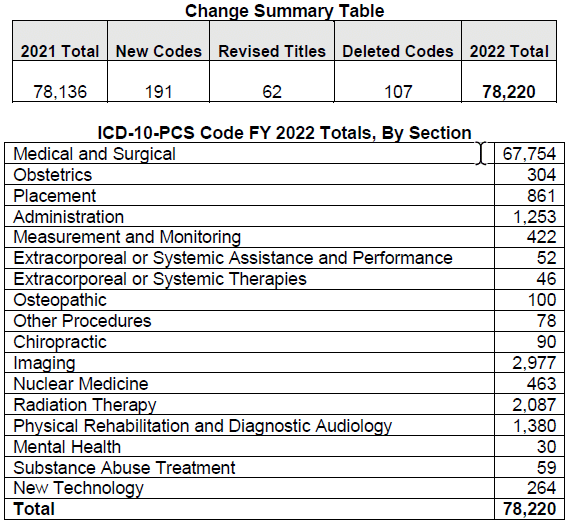In June CMS released the final ICD-10-PCS codes for FY2022, which begins October 1, 2021. We are giving you a sneak peek at the changes. HIA will have a full educational module on these changes available later this summer. Here is the summary:

Final ICD-10-PCS codes for FY2022
FY2022 ICD-10-PCS Guidelines Changes
This link will take you to the guidelines so that you can down load them. https://www.cms.gov/files/document/2022-official-icd-10-pcs-coding-guidelines.pdf
- B3.7 Control vs. more definitive root operations – Once again this guideline has been updated to clarify that Control is assigned when the procedure is done to achieve hemostasisbeyond what would be considered integral to a procedure, utilizes techniques (e.g. cautery, application of substances or pressure, suturing or ligation or clipping of bleeding points at the site) that are not described by a more specific root operation definition, such as Bypass, Detachment, Excision, Extraction, Reposition, Replacement, or Resection. They really just reworded it so it was more clear, and added several newer examples.
- B4.1c Continuous section of tubular body part – This guideline was revised to reflect the true intent and clear up misconceptions. In the past the coder was using the entry point and then going to the furthest point of the tubular body part and assigning that body part in the code. The guideline now reads that the above is not necessarily true, and the coder is to use the body part most proximal or closest to the heart. “If a procedure is performed on a continuous section of a tubular body part, code the body part value corresponding to the furthest anatomical site from the point of entry. anatomically most proximal (closest to the heart) portion of the tubular body part.” “A procedure performed on a continuous section of artery from the femoral artery to the external iliac artery with the point of entry at the external iliac artery is also coded to the external iliac artery body part”
ICD-10-PCS Character Definitions Updates
- Body parts “Dorsal root ganglion” was added to the cervical, thoracic, lumbar and spinal cord values. Fibular sesamoid and Tibial sesamoid were added to the metatarsal body parts.
- Several new devices were added to existing “Device Value Definitions” such as Carmat total artificial heart (TAH), Alfapump® system, PERCEPT™ PC neurostimulator, InterStim™ II Therapy neurostimulator, InterStim™ Micro Therapy neurostimulator, SynCardia (temporary) total artificial heart (TAH),
- Many new substances were added to existing substance values the Administration section to allow the capture of named drugs and therapies. They include gamma globulin, hyperimmune globulin, immunoglobulin, plyclonal hyperimmune globulin, OTL-101, OTL-103, AVYCAZ® Ceftazidime-avibactam, CRESEMBA® Isavuconazole (Isavuconazonium sulfate), BLINCYTO® Blinatumomab, Idarucizumab, Pradaxa® (dabigatran) , Praxbind® (dabigatran) reversal agent, INTERCEPT fibrinogen complex. Coders must review the tables and new substances to see if they are used in their facility.
- The New Technology Section X has NUMEROUS additions to Substances, many for New Technology 7 payments. Many of the new substances are drugs used to treat COVID and other conditions. They can be viewed in the tables addenda here:https://www.cms.gov/medicare/icd-10/2022-icd-10-pcs
New ICD-10-PCS Code Additions
- Body parts “Brain” and “Cerebral Hemisphere” were added for root operation Extraction to allow for coding of extraction of tissue at these sites.
- Qualifier “7-Orbital Atherectomy” was added to “coronary artery, one, two, three, four or more” body parts under root operation Extirpation to allow removal of clots in these arteries with this device
- “Coronary artery, one, two, three, four or more” and also “Intracranial artery” body parts have been added to root operation Fragmentation to allow for the coding of coronary intravascular lithotripsy (IVL) in treating calcified lesions.
- Device “Biologic with Synthetic Substitute, Autoregulated Electrohydraulic” for heart replacement and “Native Site” to qualifier for pulmonary valve replacement to allow for the placement of Harmony Transcatheter Pulmonary Valve at the native site of the valve.
- “Left ventricle” was added as a body part to root operation Restriction to allow coding of these cardiac procedures.
- The right and left brachial artery was added as a body part to root operation Bypass to allow coding of arteriovenous bypass of brachial artery to lower arm vein.
- Approach values “Via Natural or Artificial Opening” and Via “Natural or Artificial Opening, Endoscopic” were added to Occlusion of lower veins to allow for occlusion of these veins and the hemorrhoidal plexus by these approaches. Also added these two approaches to “Division, Tongue, Palate, Pharynx Muscle.”
- “Bone Marrow” body part was added to root operation Extraction. Previously the coder could only choose the bone marrow of Sternum, Iliac or Vertebral areas. This will allow the coding of extraction of bone marrow at any site.
- Liver, Liver Right Lobe or Left Lobe were added as body parts to Division root operation. Previously only the Pancreas body part was available.
- Added “Infusion Device” device to Insertion, Skull to allow for the infusion device in the skull.
- Added device “Spinal Stabilization Device Vertebral Body Tether” to Reposition of vertebra bones. It is a non-fusion spinal device intended to treat idiopathic scoliosis.
- “Sesamoid bone(s) 1st toe” added as a qualifier for Excision of Metatarsal to identify that specific part.
- Added qualifier “Humeral Surface” and “Glenoid Surface” to Removal of Shoulder Joint Synthetic Substitute.”
- Approach “Percutaneous Endoscopic’ was added to Irrigation of Peritoneal Cavity.
- Added “Cerebrospinal Fluid Shunt” as a Device under Measurement, External, Central Nervous System. The FlowSense is one kind of CSF shunt monitoring system that is adhered to the skin over the shunt tubing. The CSF can then be continually measured.
- “Automated’ was added as a qualifier for Extracorporeal Performance of Continuous Cardiac Output. Such devices are Edwards FloTrac sensor, Nexfin monitor by BMEYE, PWTT, LidCO.
- Liver was added as a body part for Fluoroscopy so that this imaging and guidance can now be coded.
New Technology Section Updates
- The New Technology Section has many new updates, too numerous to review here. They include, for example, adding computer-aided mechanical aspiration of arteries, transthoracic echocardiography computer aided guidance, Bypass of radial artery using Ellipsys® thermal Resistance Energy and new Thoraflex™ hybrid device that replaces the ascending aorta and restricts the thoracic aorta during the same procedure. Two procedures codes a needed, Replacement and Restriction codes.
- There are many new Measurement devices and techniques that have been added to XXE.
- There are many new codes for infusion of various new drugs and substances that may also have a new technology payment for FY2022. We will know which ones are finalized when the FY2022 Final Rule is released. We will have a full document listing these new drugs and substances or devices along with the procedure codes, and payment when we complete our FY2022 ICD-10 and IPPS Education Modules later this summer.
The information contained in this post is valid at the time of posting. Viewers are encouraged to research subsequent official guidance in the areas associated with the topic as they can change rapidly.





